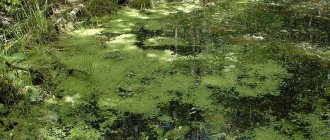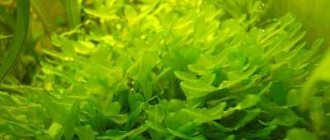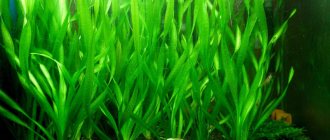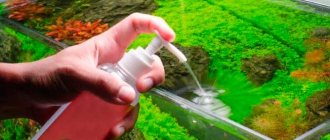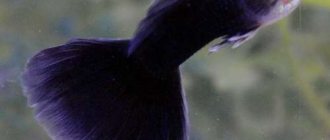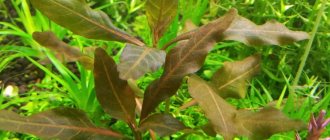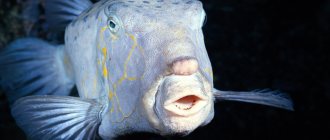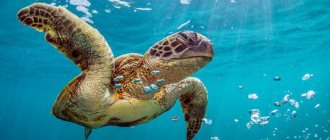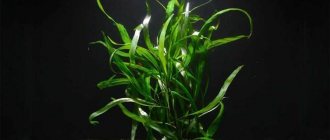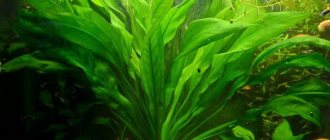It is rare that an aquarium is complete without one of the species of Echinodorus. This plant is highly decorative and has a great ability to adapt to harsh conditions. Breeders have bred more than fifty varieties of these plants. Let's look at echinodorus in our article - all types with photos and descriptions.
general description
Echinodorus are marsh plants, some of which can grow on land. Their peculiarity is the absence of a stem. Leaves grow from rhizomes. Buds form on them, from which young shoots then appear.
Under natural conditions, they live in Central and South America. Their size varies from 5 cm to 1 meter. According to the location of the rhizomes, there are horizontal and cone-shaped. The former are characteristic of creeping species, the latter – horizontally growing.
The leaves of plants have a variety of shapes and colors. According to their configuration, they are: lanceolate, oval, ellipsoid, heart-shaped. Color varies from pale green to dark cherry and even black. With the assistance of these factors, unique landscape compositions are recreated in the reservoir.
Plant propagation
The Red Pearl variety reproduces by forming buds on shoots. During this period, the plant requires special attention and additional feeding. When the buds have become stronger and have sprouted the first roots and leaves, they are removed from the mother shoot with a sharp knife and planted in a separate container in pre-prepared soil. Young shoots also develop well in nutrient pots.
Proper care and care of this plant will create an unusual bright spot in the aquarium design, pleasing to the eye and creating an aesthetically pleasing underwater landscape.
Bookmarks 0
The most popular varieties
As mentioned earlier, there are many species of Echinodorus. But still, among these aquarium plants there are those that are most beloved by owners of ponds with fish.
Amazonian
This is one of the first species adapted for home ponds. It is unpretentious, easily reproduces, and can withstand changes in water parameters. It grows both in aquariums and paludariums. The root is developed, so the soil is poured to a height of at least 5 cm.
It is a large plant, its height is approximately 40 cm, the leaves are lanceolate. Their color varies from light to dark green. In an aquarium it can grow independently or be a background for smaller bushes. Looks good in containers with a volume of 100 liters or more.
Horizontal
Also very popular among aquarium owners. Its height is 25 cm, light green leaves are heart-shaped. The name was given due to the horizontal arrangement of the shoots relative to the ground.
Loves high water temperatures (about 28 degrees). In spring and autumn, growth slows down, so during this period the temperature drops to 30 -25 degrees. The bush is spreading; it must be kept in a reservoir with a large bottom area, in the middle ground.
Narrow-leaved
This is a shrub with ribbon-shaped bright green leaves up to 60 cm high. It grows quickly, produces mustaches, thanks to which it adapts to various conditions. It easily tolerates temperature fluctuations, but the lighting must be bright, otherwise it loses its beauty.
In an acidic environment, bush growth slows down. Ribbon-shaped Echinodorus in an aquarium will look best in the background, closer to the side wall. They reproduce by numerous tendrils spreading along the ground.
Latifolius
The plant is rare. Its peculiarity is that the leaves under water and above water have different sizes. In an aquarium they are 4–5 cm wide; in a paludarium they increase in volume. The plant is a ground cover and can create a thick carpet in a short period of time. To prevent the latifolius from growing, it must be surrounded with stones.
Loves bright lighting. When weak, the echinondorus begins to stretch. Propagated by underground shoots, used for the foreground. Against its background, Echinodorus sinusoidus, which has curly cherry-colored leaves, will look beautiful.
Blechera (yarrow)
A large species, up to 60 cm high. The leaves are strong, wide, and green. One bush can consist of 30 pieces. The required temperature is 18 - 26 degrees. Propagated vegetatively or by dividing rhizomes.
This bush saturates the water with oxygen, absorbing organic waste from it. It must be placed in large containers, in the middle or background. Shade-tolerant ferns and cryptocorynes will feel good in its shade.
Cordifolia
This is a fast growing bush. Under good conditions, it can quickly grow up to 80 cm. Leaf width is 10 cm, length is 20 cm, the shape at the base is heart-shaped, the edges are wavy.
Tolerates fluctuations in water temperature from 12 to 28 degrees. Prefers bright lighting, lasting up to 10 hours. Rest is required twice a year (30 days). It is located near the back wall of the reservoir, providing a backdrop for low-growing algae.
Schlüter's leopard
It got its name due to the presence of brown spots on the light green leaves. With a lack of nutrition, they become faded. The bush is small in size, maximum height is up to 25 cm. The optimal water temperature range is 22 – 25 cm.
The plant is not tall, so it is placed in front. It does not tolerate oppression, so neighboring bushes should be at a sufficiently large distance from it. It stands out for its spreading rosette and spotted color.
Care
The Echinodorus hybrid with the name Hadi red pearl is an unpretentious aquarium plant, but there are certain parameters for its maintenance. The hybrid grows under water and in moist paludariums. The compact plant of this hybrid is well suited for growing even in a small nano aquarium. It creates a wonderful contrasting pattern of leaves of different shades. They vary in color from lush green to bright red in the center of the rosette.
The new hybrid of Echinodorus with the name Hadi red pearl will grow best in warm water with a temperature of +220C - +280C. The water in the aquarium should be soft and low acidity pH 6-7.5. The plant loves light, the optimal indicator for growing it will be 0.5-0.7 W/l.
To plant Echinodorus variety Hadi red pearl, you need to prepare fine sandy, silted, light soil rich in various nutrients. It is necessary to place microfertilizer tablets or peat and clay balls under the roots of the plant. Attractive, eye-catching, spectacular plants in your aquarium can be obtained with sufficient lighting on soil rich in nutrient compounds by applying microfertilizers containing iron.
The plant responds well with the bright color of its leaves to the addition of liquid microfertilizers to the aquarium. The Hadi red pearl hybrid does not require additional CO2 feeding, but can respond well to the addition of a small amount of this gas. The magnificent hybrid plant “Red Pearl” Hadi red pearl, with proper care and the necessary efforts of fish farmers, with its contrast of colors and unusual texture, will become a kind of bright spot and decoration of any aquarium. Planting material for Echinodorus variety Hadi red pearl must be specially ordered, because the plant is quite rare.
With bright colors
Many plants attract aquarists due to the bright colors of some species.
Ocelot
This echinodorus can be green, olive, red-brown with terracotta splashes. The plant is large and will require a large container.
It is better to place it in the middle ground. A good background for it will be bushes that form dense thickets behind. It can also be a single planted plant. Its beautiful leaves are good on their own.
Tender (Amazon in miniature)
This is a low-growing species. It requires long-term lighting, up to 12 hours. Otherwise the color becomes faded. In bright light, the bushes become dense, the leaves become ruby
Under ideal conditions, it quickly grows a dense lawn. Echinodorus tender is planted in front of other plants. Used for terrariums, aquariums.
Aflame or Purple Knight
A very impressive plant. The leaves are wavy and their color can vary from bright red to dark purple. Their brightness depends on the lighting. With a lack of nitrogen they become smaller. The bush grows up to 25 cm.
Aflame is planted in the middle of the aquarium. It will highlight the green Echinodorus well. Just as he himself will be a good background for them. In all cases, it will attract attention and create a bright spot.
Red or Red Flame
The bush has large red leaves, on which red-brown blotches are visible. When fluttering, they resemble tongues of flame, hence its name. Grows up to 40 cm.
Echinodorus is adapted to grow in hard water, but its temperature is important. It varies from 22 to 30 degrees. The bush can also be planted in greenhouses. There it will reach a height of 1 m.
Mottled
This echinodorus was bred artificially and is not found in the wild. The bush is compact, low-growing with red-brown spots.
In addition to being kept in a closed container, it can be grown as a garden plant. The bush will feel good when planted in the shallow waters of a pond in the spring and autumn. In the south it can overwinter, but provided that the roots do not freeze.
Black
It was named so for its long and oval dark brown leaves with a notch at the end. This is a fast growing bush. Up to 40 leaves grow from one rosette.
Unpretentious in content. It can grow for a short time in hard, poorly lit water. Under good conditions it grows up to 40 cm, so a large aquarium is chosen.
Barta
One of the amazing plants. Young Echinodorus has dark red leaves, while more mature ones have dark green leaves. The brightness of their color depends on the lighting and the presence of nutrients in the soil.
The lower leaves must be cut off so that they do not block the access of light. The bush takes up a lot of space, so it needs to be planted in a spacious aquarium, closer to the center.
Vesuvius
It is the product of a mutation of Echinodorus angustifolia. It appeared on the market in 2007 and immediately gained popularity. Received its name for its narrow spiral-shaped, emerald leaves, reminiscent of a volcanic eruption.
It is planted in the background of the aquarium and on its sides. Under good conditions, the plant develops an erect peduncle with small white buds.
Most beautiful
All Echinodorus can be called beautiful plants. But among them there are the most spectacular. As a rule, these are hybrids grown by breeders.
Python
Hybrid of German selection. It is considered one of the most attractive and hardy echinodorus. Even inexperienced aquarists can grow it.
While the bush is young, its leaves are light cherry, with specks. As the plant ages, they become lighter and the speckles become darker. The bush is tall, up to 50 cm, planted singly in the center or in the background.
Regina Hildebrant
The bush is of medium height, with fertilized soil reaches a height of 30 cm. The leaf plate is wavy, burgundy in color. But it only happens in bright light.
Burgundy color is the prerogative of young leaves. With age, they become dark green, and the veins and cuttings become red-brown. The bush was named in honor of the politician Dr. Regina Hildebrant.
Mercedes
A variety of Echinodorus with a stem modified into a rhizome. The leaves are wavy, lanceolate, with a pointed end. They are collected in a beautiful rosette.
Hatched young shoots are colored red. Over time they darken slightly. Old leaves are olive in color. The bush is spreading, up to 25 cm high. Its growth rate is average.
Sine wave
One of the best varieties of Echinodorus. It got its name due to the fact that its sheet plates bend in the shape of a sinusoid graph. Their color is as spectacular as their appearance. It changes as it grows from light cherry shades to darker ones.
The bush is undemanding to lighting. It may be of medium level. It will look beautiful alone in an aquarium, or as a background for low-growing plants.
Pink
This species of Echinodorus is named because it is pink in color when young. With age, it changes green, but there are always up to 5 young shoots on the bush.
Propagated vegetatively, by dividing rhizomes, shoots with daughter bushes. The plant produces inflorescences with many flower whorls. It should be planted in the center of the aquarium at a considerable distance from other bushes.
Maghrebi
This is a bush with a height and diameter of up to 30 cm. Its leaf blade is matte, with a slight gloss and wavy edges that are slightly curled on top. When young it is dark pink in color, then turns brown.
It can be planted anywhere in the aquarium. Its shoots, due to their vertical position, do not create much shade. Therefore, nearby bushes will feel comfortable.
Echinodorus "Red Devil"
Echinodorus Red Devil
In modern aquariums, a large number of different plants are grown, which not only serve as a wonderful decoration of the underwater world, but are also indispensable helpers and allies of aquarists. Echinodorus are considered one of the most popular aquarium plants. Today, their genus includes more than a hundred species and forms.
Surprisingly, they all differ significantly from each other in size, color, shape and leaf structure.
Among the Echinodorus there are very small specimens (up to 5 centimeters), and there are real giants that reach a height of 1-1.5 meters. As for the color palette of the leaves, no other plant can compare with Echinodorus. The leaves of Echinodorus play in the water with red, burgundy, brown, olive, and green hues. Many varieties have intricate patterns.
Echinodorus Red Devil
Echinodorus "Red Devil" - an unusual specimen, a hybrid obtained by crossing Echinodorus uruguayensis and Echinodorusx Red Flame, quickly gained well-deserved fame and became a welcome guest in every aquarium. It was bred in the German nursery ZOOLogiCa by the famous breeder Tomas Kaliebe.
Echinodorus Red Devil is a rosette plant with lance-shaped leaves that tend to curl. Young leaves have a rich red color, which is why Echinodorus got its name.
The wide decorative capabilities of Echinodorus “Red Devil” allow it to be used in aquascapes. Thanks to the unusual, rich color of the leaves, this plant serves as an accent to the underwater composition.
Echinodorus Red Devil photo
If we talk about the conditions of keeping Echinodorus Red Devil, there are no particular difficulties here. Echinodorus are very “hardy” plants. But it is still desirable that the water parameters be comfortable, here they are: temperature 22-27 degrees, dH up to 10, pH 6.5-7.5, intense lighting from 60 Lm/l+, CO2 supply will also have a beneficial effect on the plant habit . Filtration, aeration, and water changes are required when containing echinodorus.
In general, Echinodorus can live without additional mineral fertilizers. However, we all know what a lack, as well as an excess of macro and micro elements, leads to! Therefore, we believe that a moderate nutrient substrate or root tablets such as Tetra Planta Crypto and/or liquid macro and micro fertilizers .
The issue of lighting is very important for Echinodorus . Any small or large Echinodorus loves intense lighting ~ from 60 Lm/l. Of course, a lot depends on the type and conditions of maintenance, but in general, like any plant, Echinodorus prefers a mixed source of lighting with the creation of “sunrise-zenith-sunset”; this can be achieved with complex light panels or, for example, using T5 fluorescent lamps separately and say LED spotlights. The length of daylight hours is also an individual question, the general guideline is 6-12 hours.
Echinodorus Red Devil video review
Cool videos about plants from FanFishki
Subscribe to our YouTube channel so you don't miss anything
PRACTICAL NOTE ON GROWING AQUARIUM PLANTS
This note is posted in all FanFishka articles dedicated to aquarium plants. This is a cheat sheet with a link that will help you grow any aquarium plant and herbalist of any complexity.
Most of the reference materials are located in the Aquascape , we also recommend our brochure: Aquarium navigator for beginners: “Underwater Gardens of Babylon” .
The formula for success in growing plants can be depicted as follows.
First of all, the proper level of lighting is necessary.
(light intensity - Lumens)
Next, the proper concentration of CO2
Further macro-fertilizers and micro-fertilizers
Water parameters, care and quality water changes
The gradation of this formula is based on the degree of importance. Lighting intensity is primary, and then descending. Therefore, if your plants have holes in the leaves, they have sciatica (crooked) or there are problems with algae, then please do not read the “bad advice” - this is chlorosis (lack of iron), this is a lack of potassium... diarrhea, phimosis and endometriosis )
You always need to solve the problem of setting up an herbalist from major to minor. Plants will die more quickly from a lack of lighting than from a lack of Fe and K. Moreover, the latter are always present in one degree or another in the aquarium, but it is difficult to measure their precise value.
Below, let's go from the main to the minor.
Lighting in an aquarium with plants . Remember, the most important thing in light is its intensity (Lumens)! All other lighting characteristics: spectrum, Kelvin, PAR/PAR, Ra... are important, but secondary. There will be no intensity of lighting, there will be nothing. At the same time, the lighting intensity must be balanced - selected specifically for your project (height of the water column, number and types of plants, daylight hours).
Based on the above, choose aquarium lighting primarily by the number of lumens, and then everything else.
Lighting is the most expensive part. The most budget-friendly solution is to install ordinary construction-street floodlights above the aquarium . Fortunately, they are now very thin and aesthetic. And believe me, under them everything grows with a bang, of course, provided that all the other components are present.
In order not to be unfounded, here are photos of our herbalists, which were grown exclusively under LED spotlights or with their presence.
If you want professional lighting or aesthetics. Then you will have to fork out some money. The amounts can vary quickly from 10,000 to 50,000+ rubles for a 100 liter aquarium. For example, in 2021 we switched to professional lighting - ISTA Titan . Yes, not cheap, but the lamps are Achon! We have grown a professional competitive aquascape under them. That’s why we advise you to pay attention to them.
Well, it’s difficult to advise anything, because... Everyone has different needs and capabilities. In this article we talk about the products of our partners - Tetra , Laguna , ISTA lighting .
We tried to briefly and objectively talk about them. Then it's up to you. In any case, we do not really recommend that you pay attention to handicraft lighting assembly from folk craftsmen. Not all, but as a rule, they shove who knows what kind of diodes into such an assembly, assemble it all on their knees... and believe me, more than once on the forum you hear echoes of the consequences of such a purchase. After all, a company is a company. At a minimum, you are given warranty and post-warranty service.
If you are a beginner, your first herbalist, then LED spotlights are your choice. Let's move on, otherwise this note isn't very short =)
CO2 for aquarium plants . The plant is approximately 90% water, the remaining 10% is dry matter. Of that 10%, 46% is carbon. This is why CO2 supply is so important in a planted aquarium.
Plants in an aquarium obtain carbon “from water” - from carbon-containing compounds. But the natural concentration of C-carbon in water is small and is only sufficient for unpretentious plants, but they, and even more so, will be happy with additional carbon feeding. The supply of CO2 can be provided using mash or a CO2 balloon system , lemon juice or other methods.
The best, professional, simple and budget option is to supply carbon dioxide through a cylinder. One thing, however, is the initial purchase of a set: a cylinder, an MG valve, a diffuser…. will hit the budget.
Is it possible to do without CO2, but for a couple of bushes of simple plants ( cryptocorynes , echinodorus , most ludwigias , etc.).
What balloon systems can you recommend? The most budget option is an assembly from craftsmen who sell CO2 systems in VK and on forums. Everything is very high quality.
If you want a branded item, then we recommend the most inexpensive and at the same time high-quality CO2 systems from ISTA (Taiwan) . We have been using them for 5 years and recommend them to you.
On sale you will find two series of ISTA Aluminum CO2 Cylinder cylinders, with horizontal and vertical threads of 1 and 3 liters.
Fertilizers for an aquarium with plants . All fertilizers, of any brand, can be divided into MACRO-FERTILIZERS and MICRO-FERTILIZERS .
Macro fertilizers are nitrate NO3 and phosphate PO4 from which plants take N-nitrogen and P-phosphorus. These are the most important elements after CO2 - C-carbon.
Remember - Redfield's proportion rules . Always keep it under control and everything will be ok. Right, based on our observations, Redfield’s proportion rules only in full NPC proportions. Incomplete proportion - without carbon C does not give good results.
Micro fertilizers . These are all the other less important elements that are necessary for plants (see link). There is no point in putting too much emphasis on them. Firstly, all of them are contained in one quantity or another in tap water and are restored in the aquarium with changes. Secondly, an overdose of micro very quickly leads to an outbreak of algae.
A common mistake made by beginners is not understanding what they are pouring into the aquarium. For example, let's take such a popular and popular fertilizer as Tetra PlantaMin . Read the product summary at the link - it strengthens, stimulates, and gives a chic body shape.
A beginner, without delving into the essence, uses it and gets an outbreak of algae, writes on the forums - “Like, wow, what a bad Tetra.” And the trouble lies not in the drug, but in a lack of understanding of the nitrogen cycle and balance in the herbalist . The beginner has a Redfield bias (let’s say N and P are generally zero) and instead of making up for the lack of these primary elements, he fills the aquarium with Tetra PlantaMin - a micro-fertilizer (iron, potassium, manganese). As a result, going over the micro is only detrimental, because... plants lack the base - nitrogen and phosphorus.
Thus, you must understand what plants lack and understand fertilizers.
How to understand what plants lack? It's simple. Now the market is filled with a variety of expensive and not so expensive aquarium water tests. We recommend inexpensive domestic ones - VladOx drop tests , they are sold online and offline.
We also recommend, let’s not be afraid of this word, innovative domestic UHE tests . They are currently only sold online.
The minimum set of tests for an herbalist is NO3 and PO4. It is advisable to have the entire nitrogen range: NH4, NO2, NO3. As well as kH and pH tests.
Tests help us monitor the situation in the herbalist, but over time it is advisable to learn to see and feel the aquarium for yourself. With experience you need to move away from “convulsive testing”; the best aquarium test and tool is ourselves.
Let's summarize this part. Macro, it’s macro in Africa too. The link above generally contains a recipe on how to make them yourself. If you are not yet ready for self-mixing, then always and everywhere you will find a line of fertilizers from Tetra: Tetra Planta Macro , Tetra PlantaMicro , substrates, root tablets and much more .
Of course, there are many other brands that produce aquarium fertilizers. There is an opportunity, use even ADA products. All markers are different in taste and color. The main thing is to use it with a clear understanding of what you are using it for and what you want to get in the end.
From the professional line of fertilizers, at an adequate price, we can recommend Prodibo (soils, soils, macro, micro, stimulants, etc.).
So, something like a note turns into the Talmud. Which is not surprising - the topic is very broad. One moment left.
Water parameters for aquarium plants. Link1 and Link2 , please look at these articles, they cover the essence quite well.
Here we note that the quality of photosynthesis is influenced by the process of caring for the aquarium: water parameters (kH, pH below 7), high-quality filtration and aeration, competent and timely water changes.
Please study
Other varieties
In addition to the above, there are many other Echinodorus.
Uruguayan
Compared to other aquatic plants, it has the darkest leaves. Likes cool content. It prefers water temperatures in the range from 14 to 20 degrees.
The root system of the plant is fibrous and well developed. Its stem is straight and short. The leaves are ribbon-shaped, up to 45 cm long. This echinodorus is almost impossible to find on the market, because it is difficult to reproduce.
Ozaris
This is a spreading bush that grows up to 50 cm in an aquarium. Its leaves are hard, with visible veins. In young plants they are red, in old ones they are green.
To prevent the red color from disappearing, the plant must be fertilized with iron sulfate. You can feed every week during intensive growth.
Porto Alegre
The peculiarity of this echinodorus is that its leaf blade bends along and across its axis. Its color is dark green, lanceolate. The bush is small (up to 15 cm high), but spreading (up to 30 cm wide).
For normal development, the plant needs a large space. Does not place great demands on water temperature and degree of illumination. But it is imperative to create good filtration in the aquarium.
Khadi red pearl
Received its name for the red young leaf growing from the middle of the rosette. This is a slow growing, compact aquarium bush. The plant reaches up to 20 cm in height. The leaves are elliptical in shape.
The plant looks impressive due to the transition from red in the center to green at the edges of the bush. Can grow above the surface of the water. Thus, it is also suitable for polyudariums and terrariums.
Jungle Star
The collective name for varieties of Echinodorus bred by breeder Julius Hechstetter. Each variety is assigned a number. They all differ from each other in height, shape and color of the leaves.
This Echinodorus is easy to grow. It needs fertilized soil, warm water, bright lighting. Suitable for growing in a paludarium.
Dark
Rarely found in home aquariums due to difficulties in cultivation. The plant is capricious. Due to its slow development, it needs constant feeding.
It has tough, dark green leaves. They are ovoid in shape, their length reaches 13 cm. The veins are clearly visible on them. When transplanted, the plant needs a long time to take root.
Big
This plant has a wavy shape and light green leaf blades. The rosette is loose, due to this the bush turns out to be spreading. It reaches a height of 80 cm, so it needs to be placed in the background.
The bush has a well-branched root, so the soil height should be at least 10 cm. Echinodorus will grow well in a tropical aquarium: if the water temperature is below 22 degrees, the growth of the bush stops.
small-flowered
This bush has a short stem, the leaves are arranged in a rosette. Its peculiarity is that the shape and color of the sheet platinum depends on the degree of illumination duration. With short daylight hours (up to 9 hours) – dark green color and ovoid shape. When long (12 hours) – light green color and wedge-shaped.
The root system of this Echinodorus is well developed. She feels favorably in the water column. When the conditions necessary for it are created, the bush releases a flower arrow. He does not require a period of rest.
Red Diamond
It got its name from its red-ruby leaves. This bush will look good in the middle ground between low-growing and tall plants with a green tint to the leaves.
If an adult plant is planted in an aquarium, its roots are washed and their broken parts are trimmed. Old lower shoots are removed, and young ones will not fail to appear quickly.
Fire dancing in spring
Can be easily grown by aquarists without experience. For rapid growth, moderate lighting is enough for it. The average height of the bush is 40 cm, but it can grow up to 70.
The color of the leaves varies from olive to cherry. They contain red blotches, which, as the plant ages, change to green. They have the shape of an elongated ellipse.
St. Elmo's Fire
Medium sized bush. Its young leaves are red, with slight shading. As they age, they turn olive green. The leaf blades are elliptical, slightly elongated.
The bush can grow in hard water, but it becomes slightly smaller. Moderate lighting does not affect the color of the leaves. Prefers well-fertilized soil.
Mr. Tail recommends: Echinodorus species
The most popular varieties of Echinodorus.
Amazonian
Amazonicus is a dense bush-like growth of green elongated leaves up to 40 cm in height and up to 4 cm in width. Growth is uniform all year round. Intense sunlight is desirable, but tolerates partial shade. The soil layer must be at least 5 cm (fine gravel or coarse sand).
Cordifolia
Cordifolius is a fairly large, hard-leaved, marshy plant with sweeping green, sometimes red dotted, ovoid leaf blades, the apex of which is pointed or rounded, with a pronounced vein pattern and a heart-shaped base. An excellent choice for large aquariums, the recommended minimum of which is 200 liters. With 8 hours of daylight, it grows only under water, reaching 30 cm; when increased to 11, it begins to develop wildly, forming airy and floating leaves up to 80 cm high, and even bloom. Care includes periodic trimming by removing large leaves.
Rose
Rose is a hybrid up to 25 cm in height and up to 40 cm in diameter. The leaves are narrow, elliptical in green shades, sometimes with dark red splashes. Young shoots are pink in color. Needs regular feeding.
Red Devil
Red Devil is a bush 25 cm in diameter. Green, lanceolate-shaped leaf blades that tend to curl. The difference between the young shoots is their bright ruby color. Requires nutritious, well-silted soil. Sand is suitable as a base, but it is advisable to place a little clay under the plant.
Ruby
Rubin is a large hybrid. The recommended aquarium is at least 300 liters. Narrow, sometimes ribbon-shaped leaves up to 35 cm, on a high petiole up to 25 cm. There is a smaller variation - Narrow leaves, the bright red leaves of which have lighter veins than those of their older brother, and up to 20 cm in height. Requirements: increased lighting, nutritious soil, periodic application of fertilizers.
Dark Beauty
Dark Beauty is a small rosette up to 20 cm, with oval purple leaves. The young shoots are a rich burgundy color. Requires intense light, moderately nutritious substrate.
Ocelot
Ozelot is a medium-sized crop developed through selective breeding. Its color comes in two types: brown with dark red splashes and light green with brown specks. Peduncles are emergent. Unpretentious to lighting. Water of any hardness, neutral pH.
Saint Elmo's Fire
Sankt Elmsfeuer is a medium-sized hybrid, up to 30 cm. The leaves are ellipsoidal, up to 5 cm wide, the color of which varies from olive to bright red with small dots. Young shoots are purple in color, sometimes to shades of eggplant color, thereby reminiscent of St. Elmo's fire. Illumination is average.
Vesuvius
Vesuvius is characterized by narrow, ribbon-like leaves of a bright green color that tend to curl. The height of the rosette is up to 15 cm. To maintain its unique decorative properties, it requires intense lighting and a stable habitat. The soil should be nutritious and well silted.
Gentle
Tenellus (tenellus, herbaceous) differs from other varieties of Echinodorus in its small size (up to 6 cm) and the absence of rhizomes. Narrow green leaves up to 10 cm long and 1-3 mm wide. A fast-growing plant, ideal for both small-sized aquariums and the front part of large ones. Light-loving, picky about the soil: substrate of small fractions with a height of at least 2 cm.
Rubra
Tenellus rubra. He is also the Dwarf Chainsword. Narrow, up to 2 mm, elongated leaf plates up to 7 cm long, dark green. Under optimal conditions, young shoots have purple hues. Requires intense lighting and fine nutrient soil.
Quadricostatus
Quadricostatus is a small broad-leaved shrub of bright green color, up to 15 cm, perfect for the design of an aquarium of any size. Light – from moderate to intense. Requires nutritious soil and fertilizing with iron.
Reiners Felix
Rainer's Felix - small in size, up to 10 cm in diameter. Green shoots with red-brown pigment. Young sprouts have a golden hue and a more distinct pattern. Ideal for nano aquariums. Lighting – from moderate to intense. Requires nutritious soil and CO2 feeding.
Narrow-leaved
Angustifolius forms medium-sized bushes. Narrow ribbon green leaf blades up to 60 cm long, up to 4 mm wide. Prefers bright sunlight. Excellent tolerance to water of any hardness. A neutral pH is required.
Horizontal
Horizontally is a stemless horizontal plant with a strong root system. Color changes depending on age: from brown to light green. Lighting is average.
Blehera
Bleheri. He is also a yarrow. It is similar in appearance to the Amazon variety, but its leaves are wider (up to 8 cm) and straighter. A lush, bushy, stemless plant, up to 60 cm high, dark green in color. Unpretentious in lighting. Substrate - crushed gravel of at least 5 cm, under the rhizome - small pieces of clay. In this case, the crop can be planted in a separate pot, at the same time ensuring a good soil level. With a lack of iron, the leaves turn yellow.
Argentinian
Argentinensis is a giant representative of Echinodorus, reaching a height of over a meter in good swampy conditions, and about half a meter in an aquatic habitat. Dense dark green leaves of various shapes: round, oval, pear-shaped, elongated, etc. The soil is at least 5 cm thick.
Uruguayan
Uruguayensis is a large bush with long, elongated dark green leaves, up to half a meter high, up to 4 cm wide. It does not form an aerial part. Requires a nutrient substrate: sand, gravel.
Latifolius
Latifolius (Dwarf sword) is a dense bush-like plant with a powerful rhizome and narrow elongated light green leaf blades. It can reach a height of 15 cm. Requires intense lighting and additional CO2 supply. The soil is fine gravel or sand, at least 3 cm high. With a lack of iron, the leaves turn yellow.
Maghrebi
The Maghribian is a medium-sized hybrid. The recommended minimum aquarium size is 30 liters, up to 30 cm in diameter. Young shoots are dark pink, while mature leaves become browner. Both have wavy edges and an elongated shape.
Python
Python is a large crop, reaching half a meter in height and 40 cm in width. Dense broad-leaved rosette of green color with a brown tint. Young shoots are light cherry with dark pigment. Requires intense lighting, nutritious soil, and fertilizing.
Schluter
Schlueteri is distinguished from other varieties by small bright green ellipsoidal leaves with reddish inclusions. Slow growing crop up to 20 cm in height. Requires moderate light and nutritious soil.
Red Pearl
Hadi Red Pearl is a compact plant up to 20 cm. An excellent aquarium inhabitant even for small tanks, from 40 liters. Green wide leaves ellipsoidal in shape. Young shoots are bright red in color, based in the center of the rosette. The water is soft, acidity 6-7.5 pH.
Nazgul
Nazgul is a large hybrid, up to half a meter. The leaves are green with purple dots. The young shoots, like the peduncle, are bright pink. Requires intense lighting and moderately nutritious soil.
Osiris
Osiris. He is also Echinodorus orientalis. A hybrid with narrow long (up to 30 cm) ellipsoid or lanceolate leaves. The color depends on the conditions of detention and ranges from olive to brown-red.
Aflame
Aflame is a compact crop with large bright burgundy lance-shaped leaf blades up to 25 cm high. Intense lighting (at least 0.7 W/l), daylight hours up to 14 hours. Nutritious soil, regular fertilizing.
Hildebrandt
Regine Hildebrandt is a bush-like hybrid with cherry-colored leaves up to 20 cm in length. More mature ones acquire a brown tint, and then turn completely green. Light – moderate or intense.
Veronica
Veronicae (Florence) is a large, dense, rosette-type hybrid with narrow lanceolate leaves up to 40 cm in length, green or olive in color. Young shoots are red in color. Can form the surface part. The lighting is intense. Well silted soil.
small-flowered
Parviflorus (Black Amazon). Thick dark green leaves with dark brown veins, elongated, up to 40 cm long.
Mottled
Aspersus is a low-growing, broad-leaved, bushy plant. The leaves are green with brownish splashes, reach 10 cm in length and 6 cm in width, forming a dense dense rosette up to 20 cm in diameter.
Small bear
Kleiner Baer is a large, dense, broad-leaved hybrid, up to 40 cm high. Green leaves are ellipsoidal, wavy at the edges. Young shoots are light red in color. The lighting is intense. Requires nutritious, heavily silted soil of fine fractions.
Maintenance and care
Echinodorus, as a rule, does not get sick. And if the plant looks bad, it means it is not provided with the right conditions.
For the normal development of echinodorus, certain requirements must be met:
- change 25% of the water in the aquarium weekly;
- sufficiently bright lighting;
- saturation with carbon dioxide: if there is a lack of it, calcium will settle on the leaves;
- the presence in the reservoir of cleaner catfish and aquarium snails that can remove various deposits from the leaves;
- soil consisting of sand and gravel must be washed once a month;
- feed the plants regularly;
- Every spring, Echinodorus requires replanting, combined with dividing the overgrown bush.
If these requirements are not met, the ecosystem of the reservoir will age, creating an unfavorable environment for Echinodorus. The plant begins to signal its unfavorable condition. The bush stops growing and its leaves become smaller.
A healthy root system is white. If the roots become transparent or dark, they must be removed with a sharp knife. Then they need to be treated with activated carbon and planted in new soil.
By following these rules, the aquarist will acquire a spectacular plant in his pond that will delight him for a long time.
